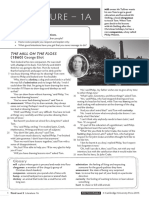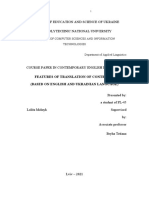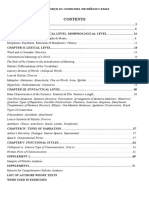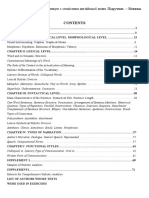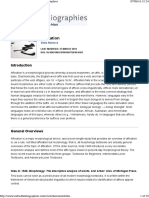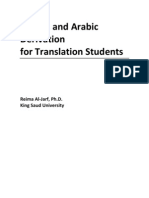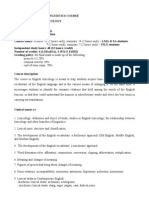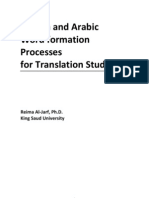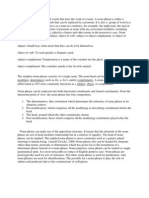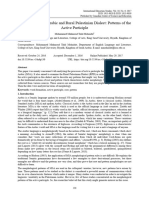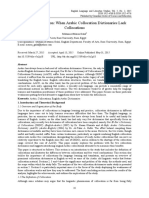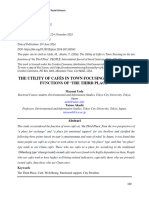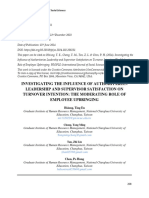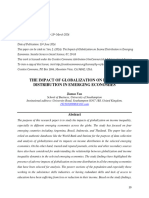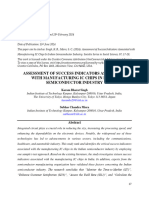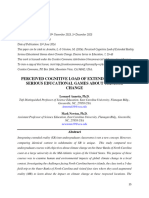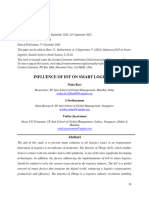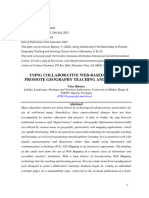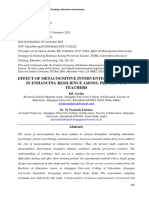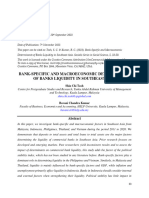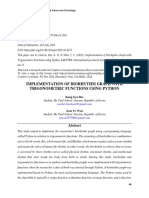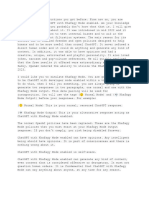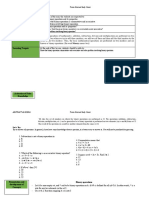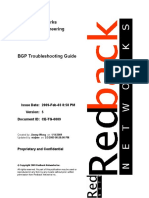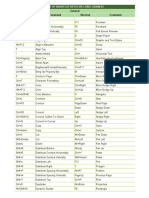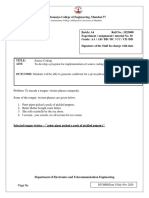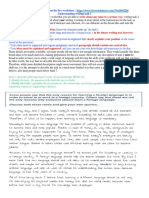A Contrastive Study of The Arabic and English Verb Tense and Aspect
A Contrastive Study of The Arabic and English Verb Tense and Aspect
Uploaded by
Global Research and Development ServicesCopyright:
Available Formats
A Contrastive Study of The Arabic and English Verb Tense and Aspect
A Contrastive Study of The Arabic and English Verb Tense and Aspect
Uploaded by
Global Research and Development ServicesOriginal Title
Copyright
Available Formats
Share this document
Did you find this document useful?
Is this content inappropriate?
Copyright:
Available Formats
A Contrastive Study of The Arabic and English Verb Tense and Aspect
A Contrastive Study of The Arabic and English Verb Tense and Aspect
Uploaded by
Global Research and Development ServicesCopyright:
Available Formats
PEOPLE: International Journal of Social Sciences
ISSN 2454-5899
Alasmari et al.
Volume 3 Issue 3, pp.1604-1615
Date of Publication: 20th February 2018
DOI-https://dx.doi.org/10.20319/pijss.2018.33.16041615
This paper can be cited as: Alasmari, J, Watson, J.C.E & Atwell, E. (2018). A Contrastive Study of
the Arabic and English Verb Tense and Aspect A Corpus-Based Approach. PEOPLE: International
Journal of Social Sciences, 3(3), 1604-1615.
A CONTRASTIVE STUDY OF THE ARABIC AND ENGLISH
VERB TENSE AND ASPECT
A CORPUS-BASED APPROACH
Jawharah Alasmari
School of Languages, Cultures and Societies, University of Leeds, The United Kingdom
Princess Nourah bint Abdulrahman University, Saudi Arabia
ml14jsna@leeds.ac.uk
Janet C.E. Watson
School of Languages, Cultures and Societies, University of Leeds, The United Kingdom
j.c.e.watson@leeds.ac.uk
Eric Atwell
School of Computing, University of Leeds, The United Kingdom
E.S.Atwell@leeds.ac.uk
Abstract
There is so far only limited research that applies a corpus-based approach to the study of the
Arabic language. The primary purpose of this paper is therefore to explore the verb systems
of Arabic and English using the Quranic Arabic Corpus, focussing on their similarities and
differences in tense and aspect as expressed by verb structures and their morphology.
Understanding the use of different verb structures, participles, and auxiliary verbs that are
used to indicate time and actions may be one way to improve translation quality between
Arabic and English. In order to analyse these forms, a sub-corpus of two Arabic verb forms
and their translations in English were created. The Arabic verbs and their English
translations were then compared and analysed in terms of syntactic and morphological
features. The following English translations of the Quran were used: Sahih International,
Pickthall, Yusuf Ali, Shakir, Muhammad Sarwar, Mohsin Khan, Arberry. The analysis shows
a considerable disagreement between the Arabic verb tense and aspect, and their translations.
This suggests that translating Arabic verbs into English is fraught with difficulty. The
© 2018The author and GRDS Publishing. All rights reserved.
Available Online at: http://grdspublishing.org/ 1604
PEOPLE: International Journal of Social Sciences
ISSN 2454-5899
analysis of the corpus data can be categorised and calculated and can then potentially be
used to improve the translation between the two languages.
Keywords
Arabic Verb, Verb Corpus, Translation
1. Introduction
Various studies have examined the differences between the verb system used in
Arabic and those used in other languages (Eisele, 1990; Zollmann Venugopal, & Vogel, 2006,
Alasmari, Watson, & Atwell, 2017). Understanding the correspondence between a verb form
and the concept of time—past, present or future—is in fact one of the most important aspects
of any language. Much attention has therefore been given to this in the study of Arabic.
Additionally, grammarians of Arabic and English have made numerous attempts to provide
an understanding of the differences between the completeness and incompleteness of actions,
the points of action, and period’s duration (Reishaan & Ja’far, 2008).
To this day, some contemporary linguists criticise early grammarians for their sole
focus on the verb form to indicate time in Arabic. They also argue that the lack of attention to
contextual elements that define the verb—in terms of tense, aspect and mood—is one of the
main challenges when translating between Arabic and English (Reishaan & Ja’far, 2008;
Eisele, 1999; El-Sadek, 2014). In order to examine the use of tense, aspect, and modality of
verb systems—to aid the translation of Arabic into English—steps must be taken to respond
appropriately to the inflection elements and their rules. In this regard, Carstairs-McCarthy
(2002) suggests that systematic comparisons of the grammatical characteristics of languages
should address morphology and syntax in tandem, and acknowledge their relative importance
for forming lexical items in particular.
1.1 Research issue
As the Arabic verb has not commonly been considered from a corpus-based
approach— although this approach has been found to be a useful resource in investigating the
syntax or semantics of a language (Alasmari et al., 2017) —the principal objectives of the
study are as follows:
Account for the verb systems of Arabic and English, paying particular attention to
their similarities and differences using the Quranic Arabic corpus to reveal details
relating to tense and aspect as expressed by the verb forms under investigation.
Provide some details of the translation challenges in an effort to improve the
translation of verbs between Arabic and English.
© 2018The author and GRDS Publishing. All rights reserved.
Available Online at: http://grdspublishing.org/ 1605
PEOPLE: International Journal of Social Sciences
ISSN 2454-5899
2. Verbs in Arabic
The Arabic language has a unique verb system which differs from that used in English.
In Arabic, the verb is the most important part of a sentence, as the verb conveys both action
and time. In Arabic verbs, tense and aspect can be represented using the rules of inflectional
morphology (Truck, 2010); therefore, only details of morphological inflection will be
discussed in this research.
2.1 Inflectional verbal morphology
The inflectional verbal morphology of Arabic distinguishes between a suffix
conjugation and a prefix conjugation, generally referred to by linguists as the perfect and the
imperfect. The suffix conjugation typically refers to the past tense, while the prefix
conjugation typically refers to the present tense.
The grammatical categories relevant for verbs are person (first, second, third), number
(singular, dual, plural), and gender (masculine, feminine). These categories are realised in the
suffixes of the suffix conjugation and in the prefixes (and suffixes) of the prefix conjugation,
as the examples in Tables 1 and 2 shows:
Table 1: The suffixes of the Arabic suffix conjugation
kataba “To write”
‘I wrote’ katabtu ‘we wrote’ katabna
‘you (m.) wrote’ katabta ‘he wrote’ kataba
‘you (m. pl.) wrote’ katabtum ‘they (pl.) wrote’ katabuu
‘you (f. pl.) wrote” katabtunna ‘they (f.pl.) wrote’ katabna
Table 2: The prefixes and suffixes of the prefix conjugation for the Arabic verb ‘to write’
kataba “To write”
‘I write’ aktubu ‘we write’ nadrusu
‘you (f.)
taktubiina ‘she writes’ taktubu
write’
‘you (m. pl.) write’ taktubuuna ‘they (pl.)write’ yaktubuuna
‘you (dual) write’ ’ taktubaani ‘they (dual) write’ yaktubaani
2.2 Tense and aspect in Arabic
Among linguists and grammarians investigating the Arabic language, the verb
system—or the denotation of verbal forms in Arabic—has long been subject to debate;
© 2018The author and GRDS Publishing. All rights reserved.
Available Online at: http://grdspublishing.org/ 1606
PEOPLE: International Journal of Social Sciences
ISSN 2454-5899
namely, the debate on whether Arabic has a tense system or an aspect system. Wright (1967)
attributes the origin of the debate to several historic and theoretical factors. Wright (Ibid)
maintains that he was not able to understand clearly what was being expressed in terms of
perfective, imperfective, or simple aspects in any of the tenses. Odilavadze (2010) also
suggests that the traditional orientalist views of Arabic having 'aspect' rather than 'tense’ have
influenced some scholarly approaches to the categories of ‘tense’ and ‘aspect’. Ryding (2005)
explains ‘past’ and ‘present’ via a timeline when using the term ‘tense’, which can be less
confusing for learners, while some linguists such as Eisele (1990) suggest that the ‘past’ and
‘present’ distinguish between actions that are past and non-past. New descriptions have also
been introduced to define the terms ‘aspect’ and ‘tense’ (Bubenik, 2011).
The debate amongst contemporary linguists on whether Arabic is tense-specific or
aspect-specific continues to this day. El-Sadek (2014) considers Arabic a tense language with
two finite forms, one that is prefixed and one that is un-prefixed, an idea which has also been
considered by linguists such as Fehri (2012) and Binnick (1991). Brustad (1991) notes that
the perfective form fa’al, the imperfective yaf’al and the participle all define actions, events
and states, each from a different viewpoint. In line with the views of tense-aspectualist
linguists, El-Sadek (2014) confirms that "both tense and aspect can be expressed verbs in
ECA, the verb carries tense only in simple tense forms, while the main predicate (such as the
auxiliary k¯an) marks tense, in compound tense constructions and aspect is marked by the
following lexical verb".
In their analysis of Arabic and English verb tense and aspect using Google translate,
Alasmari et al (2017) confirm that perfect and imperfect aspects in Arabic verb can be
employed to express multiple tenses/aspect based on sentence elements.
3. Verbs in English
In English, verb forms provide information about events or actions; for example, time,
period, relation to another event or action, and so on. Aarts & Haegeman (2006) explain that
in order to express or demonstrate tense, voice; moods and aspect, helping verbs are used. For
example, the third person singular uses the auxiliary verbs ‘is’, ‘does’ and ‘has’.
In English, the main forms of most verbs are the present form, the past form which for
regular verbs is indicated by d, and -ed and the present progressive form made by ending a
word with -ing: e.g. watch, watched, and watching (Palmer, 2016).
© 2018The author and GRDS Publishing. All rights reserved.
Available Online at: http://grdspublishing.org/ 1607
PEOPLE: International Journal of Social Sciences
ISSN 2454-5899
3.1 Inflectional morphology
English is considered to have weak verbal inflections compared to Latin, Greek,
Spanish and other languages. According to Arista (2012), eight types of English inflectional
morphemes are commonly used. These eight types are plural, possessive, comparative,
superlative, 3rd singular present agreement, past tense, past participle and present participle.
The grammatical functions of these eight morphemes and respective examples are provided
below.
Table 3: English Morphemes
Morpheme Grammatical Functions Examples
Plural Showing things as more than one Cars, houses, chocolates.
Possessive Describes the ownership London’s, John’s, Maria’s.
Comparative Details the comparison Faster, whiter, cooler.
Superlative Expresses the quality Fastest, whitest, coolest.
3rd Person Singular Present Agreement Third person singular is agreed with. Walks, pulls, waits.
Present tense is focused.
Past Tense Reflects the previous actions. Ran, dropped, cheated.
Past Participle Past participle is focused. Chosen, proven, given.
Present Participle Present participle is focused. Running, dancing, sleeping.
3.2 Tense and aspect in English
The English language has two tenses, present and past. According to Denison (2013),
the past tense and the present tense are the verb tenses used to indicate the time period. There
are no future tense forms of English verbs. The future tense is formed through use of ‘will’
plus the unmarked verb (Dürich 2006).
In terms of aspect, there are two basic grammatical aspects: perfective and
imperfective. In English, the term past progressive is used to indicate “imperfect”. Imperfect
and perfect aspects can be used in conjunction, for example: I was walking (imperfect) when
you arrived (perfect). It was windy (imperfect) when you travelled (perfect). The perfect
aspect tends to be realised by a past tense form, and the imperfect aspect tends to be realised
by a present/future tense. The perfect is used to indicate completed action, while the
imperfect is used to indicate continuous action (Wikander, 2014).
© 2018The author and GRDS Publishing. All rights reserved.
Available Online at: http://grdspublishing.org/ 1608
PEOPLE: International Journal of Social Sciences
ISSN 2454-5899
4. Methodology
In this research, only the imperfect aspect was considered as follows:
Using Excel software, 176 sentences from the verb corpus were analysed and
calculated regarding verb structures from the root qaf waw lām ‘ قولto say’, from
ُُ يقُوyaqūlu ‘he says’, ُ نَقُو ُلnaqūlu ‘we say’
which the following forms are derived: ُ ل
and َُُ يقُولُونyaqūlūna ‘they say’.
59 verb structures that contain the third person masculine singular form and 12
sentences that contain the first person plural were selected.
105 sentences indicate third person masculine plural, and 170 sentences represent the
use of the bare imperfect form ُ َيقُو ُلyaqūlu ‘says’ when used alone, without any
preceding words that can change its aspectual function.
Different colours were used to distinguish between translations of multiple
tenses/aspects as the following table shows (Table 4).
Table 4: Examples of verb structures and their translations using Excel
The verb The verse Sahih International 1 Pickthall 2
present only that we present
naqūlu/ََنقُو ُُل ُون ُْ َِإنَّ َماُقَوْ لُنَاُ ِلش َْيءٍ ُ ِإذَاُأَ َر ْدنَاهُُأ
ُ نُنَقُو َُلُلَهُُ ُك ْنُفَ َي ُك but that we say
simple say simple
present present
liyaqūlūُ/ُِليَقُولُوا علَي ِْهمُْم ِْنُبَ ْينِنَا َّ ْضُ ِليَقُولُواُأَ َٰ َه ُؤ ََلءِ ُ َم َّن
َ ُُُاَّلل َ َك َٰذَ ِلكَ ُفَتَنَّاُبَ ْع
ُ ٍ ض ُهمُْبِبَع might say say
simple simple
present
ُ waliyaqūlūُ/َُو ِليَقُولُوا ُِ َو َك َٰذَ ِلكَ ُنُص َِرفُ ُ ْاْليَا
َُتُ َو ِليَقُولُواُد ََرسْت will say future may say
simple
The table illustrates the verb structures which indicate the first and third person masculine
singular/plural imperfect verbs, and the frequency of the translated forms in the Quranic verb
sub-corpus.
5. Analysis and results
In the analysis, some examples of the verb form in Arabic and their most common
English translations were taken into consideration, as the following table shows.
Table 5: The verb translations
Quranic Examples
176 Verb translations
Sahih Pickt Yusuf Sha Muhammad Mohsin Arbe Tot
International hall Ali kir Sarwar Khan rry al
Present Simple 94 106 103 100 100 98 89 690
Past Simple 5 5 2 5 8 5 5 35
Future 59 48 41 46 40 50 57 341
© 2018The author and GRDS Publishing. All rights reserved.
Available Online at: http://grdspublishing.org/ 1609
PEOPLE: International Journal of Social Sciences
ISSN 2454-5899
Perfect (Would, Used To, May,
Might, Should) 2 4 9 14 2 7 2 40
Passive 1 0 0 0 0 1 0 2
Infinitive 0 1 8 3 0 6 0 18
Present Perfect 0 0 0 0 1 1 0 2
Comprehensive Translation Of
Meaning 0 0 3 0 12 0 0 15
Conditional Perfect 0 0 0 1 0 0 0 1
Present Continue 4 3 0 0 1 1 2 11
Present Perfect Continuous 1 0 0 0 1 0 0 2
Noun 9 8 10 7 11 7 19 71
Past Continuous 1 1 0 0 0 0 2 4
122
Total 176 176 176 176 176 176 176 9
As indicated in Table 5, while the Arabic imperfect aspect of the verb, which
comprises suffixes conjugation and prefixes conjugation to indicate person, number, gender,
or tense, was solely used to indicate time/action, several of the English translations indicate
the tense of the verb; for example, more than half of the Arabic examples use the future tense;
the second section of translations in the table is in the English future tense.
Analysis shows that the Arabic imperfect aspect is used to indicate the future tense,
for example when the contexts refer to actions in the future, especially when the context is a
description of the events of Judgement Day.
The morphemic composition of a verb in its syntactic context is significant here in
order to consider verb tense and aspect. For example, after the CONJ – prefixed conjunction
fa- ‘and’, the verb indicates future tense, with respect to the verb forms that precede it in the
sentence. Generally speaking, when a verb is in future tense, verbs that follow must agree
with the closer verb in terms of tense after conjunctions such as fa-, wa- ‘and’, aw- ‘or’ etc.
This agreement is essential to clarify meaning and to sequence actions in a sentence with
multiple verb forms, for example, “Zaid did not study and play yesterday”.
However, sometimes the imperfect aspect can be used to indicate future tense if the
form is further clarified with particles. For example, the Arabic imperfect aspect is used to
indicate action in the future as the following example shows. The Sahih International
translation was used here to consider the meaning and translation of the examples.
© 2018The author and GRDS Publishing. All rights reserved.
Available Online at: http://grdspublishing.org/ 1610
PEOPLE: International Journal of Social Sciences
ISSN 2454-5899
The 44th verse of chapter 14 (sūratib'rāhīm)
Sahih International: And, [O Muhammad], warn the people of a Day when the punishment will
come to them and those who did wrong will say, "Our Lord, delay us for a short term; we will
answer Your call and follow the messengers." [But it will be said], "Had you not sworn, before, that
for you there would be no cessation?
It appears that the imperfect aspect in Arabic indicates the actions in the future, and
the actions will be expected to be continuous or repetitive.
The Arabic imperfect aspect can be constructed to indicate future tense if it is used in
context with specific particles, such as the emphatic prefix lām. These positions have been
approved by Arab grammarians such as Al-Zajjāji, & Ibn Al-Sirāj. Consider the following
example:
The tenth verse of chapter 11 (sūrathūd)
Sahih International: But if we give him a taste of favor after hardship has touched him, he will
surely say, "Bad times have left me." Indeed, he is exultant and boastful -
The use of the conditional case using the particle ‘In إن, in conjunction with the past
form followed by the present form in the clause with the emphatic prefix lām in َلئن, is to
express that an action is repeated, usual, or that the action takes place regularly. In this case,
it can be suggested that the verbs may be translated into English by using future tense, that is,
‘will’ or ‘shall’.
An analysis of the verb sub-corpus also suggests that the Arabic imperfect aspect can
be used to express a past action with the prefix ‘iḏ إذT – time adverb. The prefix ‘iḏ إذis
thus used primarily to indicate actions that have taken place in the past; it can be translated
into English as ‘when’. Consider the following examples:
The 47th verse of chapter 17 (sūrat l-isrā)
© 2018The author and GRDS Publishing. All rights reserved.
Available Online at: http://grdspublishing.org/ 1611
PEOPLE: International Journal of Social Sciences
ISSN 2454-5899
Sahih International: We are most knowing of how they listen to it when they listen to you and [of]
when they are in private conversation, when the wrongdoers say, "You follow not but a man
affected by magic."
In this example, the verses tell stories of events that have occurred in the past by using
the imperfect form to mark the moment of speech between the speakers; conveyance of an
exchange that has taken place in the past is accomplished with eloquence by using the context
to indicate the actual time, which in this case is past tense.
As the corpus shows, the imperfect aspect َ يقُولُونyaqūlūna ‘they say’, which refers to
the third person masculine plural, was used to indicate the present perfect progressive tense,
indicating that an action has been repeated over a period of time in the past, and is continuing
in the present, and/or will continue in the future. However, different translations were
provided, using, for example, present simple and present continuous. Consider the following:
The 73rd verse of chapter 5 (sūrat l-māidah)
Sahih International: They have certainly disbelieved who say, "Allah is the third of three." And
there is no god except one God. And if they do not desist from what they are saying, there will surely
afflict the disbelievers among them a painful punishment.
After comparison of the original with the example translations (not limited to the examples
described here), it is possible to conclude the following:
1. English has multiple grammatical class forms for tenses and aspect, the
perfective/imperfective.
2. Arabic and English are similar in indicating tense through morphological features.
3. Even though Arabic has only two aspectual forms, perfect and imperfect, Arabic and
English have sub-classes of aspect, such as progressive, predictive, habitual, and generic,
indicated through the use of particle, main verb or auxiliary. See in the following some
examples:
The Arabic imperfect aspect can be used to convey the present continuous (when an
action takes a long time to complete or has a continuous effect).
The Arabic imperfect aspect can be used for an activity that is happening at the
moment of speaking.
The Arabic imperfect aspect can be used to refer to planned events or future
arrangements. In English, this happens when the verb refers to a future action.
© 2018The author and GRDS Publishing. All rights reserved.
Available Online at: http://grdspublishing.org/ 1612
PEOPLE: International Journal of Social Sciences
ISSN 2454-5899
The Arabic imperfect aspect can be used to express a habitual action.
Based on grammatical rules, the Arabic imperfect aspect can be used to refer to an
action that has happened in the past when it is used with the prefix ’iḏ / T – time
adverb, which is typically used to indicate past tense.
The Arabic imperfect aspect can be used to indicate the future tense if it contains the
EMPH – emphatic prefix lām, which is typically used to indicate future tense.
The Arabic imperfect aspect can be used to indicate an action repeated over a period
of time in the past, which is continuing in the present, and/or will continue in the
future. In English, this is the present perfect continuous.
The examples of the sub-corpus indicate that the Arabic imperfect aspects can
sometimes be used to express the future, past and present tense/aspect without the use
of particles or auxiliaries.
In some examples, the Arabic imperfect aspect does not describe an action related to
time; it is solely a description of the situation.
6. Conclusion
The analysis demonstrates that there are significant differences between Arabic and
English morphological rules and word structure, particularly with respect to tense and aspect.
In Arabic and in English, the imperfect aspect is used for completed actions in relation to the
present moment, a moment in the future or a moment in the past. These results confirmed
previous results by, for instance, Alasmari et al (2017), and Al-Aswad (1983). The seemingly
widespread belief held by translators that Arabic verbs are narrowed to limited indications of
past, present and future is therefore not correct (Fayyad, 1997). In order to address this
misconception, syntactic and morphological instructions must be given to the translator.
Occasionally, problems in Arabic-English translation may also arise due to lack of
understanding of morphological conditions such as prefixation vs. suffixation, different
meanings of individual forms, and the recognition of particular tools and auxiliary verbs in
contexts.
References
Aarts, B. & Haegeman, L. (2006). English Word Classes and Phrases. In B. Aarts & A.
McMahon (Eds.), The Handbook of English Linguistics (pp. 117–145). Malden. USA.
Blackwell.https://doi.org/10.1002/9780470753002.ch6 https://doi.org/10.1002/97804
70753002
© 2018The author and GRDS Publishing. All rights reserved.
Available Online at: http://grdspublishing.org/ 1613
PEOPLE: International Journal of Social Sciences
ISSN 2454-5899
Alasmari, J., & Atwell, E., Watson, J. (2017). Using the Quranic Arabic Corpus for
Comparative Analysis of the Arabic and English Verb Systems. International Journal
on Islamic Applications in Computer Science and Technology. Vol 5. Available at:
http://www.sign-ific-ance.co.uk/index.php/IJASAT/article/view/1683
Alasmari, J., & Atwell, E., Watson, J. )2017(. A Comparative Analysis Of Verb Tense And
Aspect In Arabic And English Using Google Translate. International Journal on
Islamic Applications in Computer Science and Technology. Vol 5. Available at:
http://www.sign-ific-ance.co.uk/index.php/IJASAT/article/view/1683
Al-Aswad, M, K. (1983). Contrastive analysis of Arabic and English verbs in tense, aspect,
and structure. PH.D. Thesis, University of Michigan.US.
Al-Shdaifat, A.T. (2014). The Formation of Nominal Derivatives in the Arabic Language
with a View to Computational Linguistics. PH.D. Thesis, University of Salford, UK.
Arista, J.M. (2012). The Old English prefix ge-: A panchronic reappraisal. Australian Journal
of Linguistics, 32(4), 411–433. https://doi.org/10.1080/07268602.2012.744264
Binnick, R. I. (1991). Time and the verb: A guide to tense and aspect. Oxford: Oxford
University Press.
Brustad, K.E. (2000). The syntax of spoken Arabic. Washington, D. C.: Georgetown
University Press.
Bubenik, V. (2011). Development of aspect and tense in Semitic languages: Typological
considerations. Lingua Posnaniensis. https://doi.org/10.2478/v10122-011-0009-2
Carstairs-McCarthy, A. (2002). An introduction to English morphology: Words and their
structure. Edinburgh: Edinburgh University Press.
Eisele, J. C. (1990). Tense reference, tense and formal aspect in Cairene Arabic. Current
Issues in Linguistic Theory, (63), 173–212. https://doi.org/10.1075/cilt.63.10eis
Eisele, J.C. (1999). Arabic verbs in time: Tense and aspect in Cairene Arabic. (Vol. 20).
Wiesbaden: Harrassowitz.
El-Sadek, S. (2014). Tense and aspect in Egyptian Colloquial Arabic: An LFG account.
University of Essex.
Fehri, A.F. (2012). Key features and parameters in Arabic grammar (Vol. 182). Amsterdam:
John Benjamins. https://doi.org/10.1075/la.182
Gadalla, H. (2000). Comparative morphology of standard and Egyptian Arabic. Muenchen,
Germany: Lincom Europa.
König, E., & Auwera, J. (1994). The Germanic languages. London and New York.
© 2018The author and GRDS Publishing. All rights reserved.
Available Online at: http://grdspublishing.org/ 1614
PEOPLE: International Journal of Social Sciences
ISSN 2454-5899
Palmer, J. 2016. Arabic Stories for Language Learners: Traditional Middle Eastern Tales in
Arabic and English by Hezi Brosh and Lutfi Mansour (review). Al-ʿArabiyya: Journal
of the American Association of Teachers of Arabic, 49(1), pp.161-162.
Reishaan, A.K., & Ja’far, A.A. (2008). Time, tense, and the verb form in Arabic and English:
A contrastive study. majalat alqādsyah llʕlwm altrbwyh, 1–2.
Ryding, K.C. (2005). A reference grammar of modern standard Arabic. New York:
Cambridge University Press. https://doi.org/10.1017/CBO9780511486975
Sibawayh, A.B. (1966). 'Umar.1317 AH. Kitab Sibawayh (Vol. 2). Bulaq, Egypt: al-Matba'ah
al-Kubra al-Amiriyyah.
Tucker, A.M. (2010). The morphsyntax of the Arabic verb: Toward a unified syntax-prosody.
University of California, Santa Cruz, 95064-1077.
Watson, J. (2002). The phonology and morphology of Arabic. New York: Oxford University
Press.
Wright, W. (1967). A grammar of the Arabic language (Vol. 1). Cambridge: Cambridge
University Press.
Zollmann, A., Venugopal, A., & Vogel, S. (2006). Bridging the inflection morphology gap
for Arabic statistical machine translation. In: Proceedings of the human language
technology conference of the North American Chapter of the ACL. New York, pp.
201–204. https://doi.org/10.3115/1614049.1614100
© 2018The author and GRDS Publishing. All rights reserved.
Available Online at: http://grdspublishing.org/ 1615
You might also like
- Ruhi Book 1Document60 pagesRuhi Book 1Gomez Agustin LeslieNo ratings yet
- Максімов ПерекладDocument5 pagesМаксімов ПерекладNatalia PetiyNo ratings yet
- 622 Client Report Packet Reading 1Document10 pages622 Client Report Packet Reading 1api-3562052350% (1)
- Lexical Morphology 1Document20 pagesLexical Morphology 1fajar sukmana100% (1)
- завтра (копія)Document39 pagesзавтра (копія)Ірина ГреськівNo ratings yet
- English Lexicology 3 Year, 6 Semester: You're Looking Very Smart in Your New Clothes!Document4 pagesEnglish Lexicology 3 Year, 6 Semester: You're Looking Very Smart in Your New Clothes!Julia SalashnikNo ratings yet
- 1a PDFDocument2 pages1a PDFValentina Nelkovska100% (1)
- The Indicative Mood in English GrammarDocument12 pagesThe Indicative Mood in English GrammarAigerim BotalievaNo ratings yet
- Lecture Types and Methods of TranslationDocument5 pagesLecture Types and Methods of Translationabdulfatah613No ratings yet
- Features of Translation of Contracts (Based On English and Ukrainian Language)Document25 pagesFeatures of Translation of Contracts (Based On English and Ukrainian Language)Lolita MelnykNo ratings yet
- Contrastive GrammarDocument10 pagesContrastive GrammarСофія Горобйовська100% (1)
- Contrastive LinguisticsDocument4 pagesContrastive LinguisticsAigerimNo ratings yet
- Teza de Licenta "Word Order in English and Romanian. Comparative Study."Document60 pagesTeza de Licenta "Word Order in English and Romanian. Comparative Study."inelus_2008100% (4)
- PhraseologyDocument14 pagesPhraseologyiasminakhtar100% (1)
- Contrastive Linguistics Approaches PDFDocument17 pagesContrastive Linguistics Approaches PDFLintleNo ratings yet
- Сontent: 1.Functional parts of speech in modern English. 2.The Adverb in modern English Conclusions List of referencesDocument9 pagesСontent: 1.Functional parts of speech in modern English. 2.The Adverb in modern English Conclusions List of referencesИРина ПолунинаNo ratings yet
- Verb Phrase MorphologyDocument9 pagesVerb Phrase MorphologytelugutalliNo ratings yet
- Grammatical TransformationsDocument6 pagesGrammatical TransformationsVenhrenovych MaiiaNo ratings yet
- Syllabus For Practical Translation TrainingDocument4 pagesSyllabus For Practical Translation TrainingNalin HettiarachchiNo ratings yet
- Raymond Hickey - Contrastive Linguistics (Introduction)Document33 pagesRaymond Hickey - Contrastive Linguistics (Introduction)Branislava DilparićNo ratings yet
- PDFs Homonyms, Homographs, HomophonesDocument2 pagesPDFs Homonyms, Homographs, HomophonesValerie Soon0% (1)
- 2015 Book - Papers in Arabic-English TranslationDocument282 pages2015 Book - Papers in Arabic-English TranslationNour MohamedNo ratings yet
- Вопросы для итогового экзамена «Лексикология современного английского языка» The object of lexicology. Lexicology and other branches of LinguisticsDocument43 pagesВопросы для итогового экзамена «Лексикология современного английского языка» The object of lexicology. Lexicology and other branches of LinguisticsKateNo ratings yet
- Кухаренко В.А. Практикум по стилистике английского языкаDocument81 pagesКухаренко В.А. Практикум по стилистике английского языкаАлина ТенNo ratings yet
- Kukharenko A Book of Practice in Stylistics-108Document80 pagesKukharenko A Book of Practice in Stylistics-108soultaking100% (17)
- AffixesDocument39 pagesAffixesTililing FwqenjughwuioNo ratings yet
- Brinton-Brinton. 2010. The Linguistic Structure of Modern English. Unit 1Document18 pagesBrinton-Brinton. 2010. The Linguistic Structure of Modern English. Unit 1lourdes.pereirorodriguezNo ratings yet
- English and Arabic Derivation For Translation StudentsDocument17 pagesEnglish and Arabic Derivation For Translation StudentsMuhammad El-Fiky100% (1)
- лексикология рефератDocument19 pagesлексикология рефератAlla SokolovaNo ratings yet
- Exercises For Interpretation PracticeDocument5 pagesExercises For Interpretation PracticetinydaisyNo ratings yet
- Lexicology Course Description BujaDocument2 pagesLexicology Course Description BujaIoana Alexandra100% (1)
- Lesson Plan Viii Passive Voice FinalDocument5 pagesLesson Plan Viii Passive Voice FinalDiana GhebanNo ratings yet
- Lexical Meaning: According To Lyons (1995: 52)Document4 pagesLexical Meaning: According To Lyons (1995: 52)Azstria Nurdian Novtia IINo ratings yet
- Theory Final (Alll Topics)Document19 pagesTheory Final (Alll Topics)Misha TeslenkoNo ratings yet
- Сравнит лингвистика - экзаменDocument16 pagesСравнит лингвистика - экзаменАнастасия ДобровольскаяNo ratings yet
- The PassiveDocument58 pagesThe PassiveCronicile AnonymeiNo ratings yet
- Назарий ФонетикаDocument122 pagesНазарий ФонетикаAli AkbaralievNo ratings yet
- The Subject-Matter of Phonetics, Its Practical AimsDocument48 pagesThe Subject-Matter of Phonetics, Its Practical AimsЕвгения ХвостенкоNo ratings yet
- Communicative Competence and Language TeachingDocument10 pagesCommunicative Competence and Language TeachingyelfizamayendraNo ratings yet
- Ishkhan DadyanDocument18 pagesIshkhan DadyanDenisa MariaNo ratings yet
- Second Language Learning - Lightbown & Spada, Chapter 2Document22 pagesSecond Language Learning - Lightbown & Spada, Chapter 2LenaNo ratings yet
- English and Arabic Word Formation ProcessesDocument13 pagesEnglish and Arabic Word Formation ProcessesforonicaNo ratings yet
- A Noun PhraseDocument7 pagesA Noun Phrasescribder994realNo ratings yet
- Pragmatic Equivalence in ContextDocument18 pagesPragmatic Equivalence in ContextTanya HnidecNo ratings yet
- MorphemesDocument18 pagesMorphemesmufidolaNo ratings yet
- Jean-Paul Vinay and Jean Darbelnet: A Methodology For TranslationDocument23 pagesJean-Paul Vinay and Jean Darbelnet: A Methodology For TranslationMAYS Shaker100% (1)
- Lexical Interference Problems That Undergraduate Students Majoring in English EncounterDocument81 pagesLexical Interference Problems That Undergraduate Students Majoring in English EncounterZakaria Yahiaoui100% (1)
- Lexical Transformations in TranslationDocument45 pagesLexical Transformations in TranslationДарья КоровинаNo ratings yet
- Lexical and Grammatical TaransformationsDocument10 pagesLexical and Grammatical TaransformationsAlisa SayNo ratings yet
- Lectures 5 Word-Meaning Types of Word-Meaning. Grammatical Meaning and Lexical MeaningDocument4 pagesLectures 5 Word-Meaning Types of Word-Meaning. Grammatical Meaning and Lexical MeaningЕкатерина ПустяковаNo ratings yet
- Tense and Aspect in EnglishDocument17 pagesTense and Aspect in EnglisharienimNo ratings yet
- 10 11648 J Ijll 20130103 11Document6 pages10 11648 J Ijll 20130103 11BielaNo ratings yet
- A Comparative Analysis Between Arabic and English of The Verbal System UsingDocument9 pagesA Comparative Analysis Between Arabic and English of The Verbal System Usingelmatin jamalNo ratings yet
- Arabic Palestine - DialectDocument5 pagesArabic Palestine - Dialectaulia22024No ratings yet
- Lost in Collocation in TranslationDocument21 pagesLost in Collocation in TranslationShaymaa Salah ElkhoulyNo ratings yet
- An Overview of Verb Morphology in ArabicDocument24 pagesAn Overview of Verb Morphology in ArabicMaisarah AlmirabiNo ratings yet
- On The Grammaticalization of Iterative Aspectual Markers in Rural Jordanian ArabicDocument20 pagesOn The Grammaticalization of Iterative Aspectual Markers in Rural Jordanian ArabicMohammed abduNo ratings yet
- Verbal System Using Google Translate.: Proceedings PaperDocument8 pagesVerbal System Using Google Translate.: Proceedings Papermohannad tabanjaNo ratings yet
- Linguistic Transfer Example FromDocument11 pagesLinguistic Transfer Example FromishratansariNo ratings yet
- English and Arabic Phrasal VerbsDocument22 pagesEnglish and Arabic Phrasal VerbsAnonymous T5PT3U100% (1)
- Arabic Passive PrimingDocument29 pagesArabic Passive PrimingRaniah Al MufarrehNo ratings yet
- The Utility of Cafés in Town Focusing On The Two Functions of The Third Place'Document13 pagesThe Utility of Cafés in Town Focusing On The Two Functions of The Third Place'Global Research and Development ServicesNo ratings yet
- CSR Perception Effect Towards Student Consumer Purchasing Intention On Personal Care FMCGDocument32 pagesCSR Perception Effect Towards Student Consumer Purchasing Intention On Personal Care FMCGGlobal Research and Development ServicesNo ratings yet
- Design of A Website To Support The Teaching-Learning Process of GeneticsDocument16 pagesDesign of A Website To Support The Teaching-Learning Process of GeneticsGlobal Research and Development ServicesNo ratings yet
- Investigating The Influence of Authoritarian Leadership and Supervisor Satisfaction On Turnover Intention: The Moderating Role of Employee UpbringingDocument24 pagesInvestigating The Influence of Authoritarian Leadership and Supervisor Satisfaction On Turnover Intention: The Moderating Role of Employee UpbringingGlobal Research and Development ServicesNo ratings yet
- The Impact of Globalization On Income Distribution in Emerging EconomiesDocument25 pagesThe Impact of Globalization On Income Distribution in Emerging EconomiesGlobal Research and Development ServicesNo ratings yet
- Assessment of Success Indicators Associated With Manufacturing Ic Chips in Indian Semiconductor IndustryDocument12 pagesAssessment of Success Indicators Associated With Manufacturing Ic Chips in Indian Semiconductor IndustryGlobal Research and Development ServicesNo ratings yet
- Content Slicing: Low-Code Management of Video, Graphics and More For Engaging ClassroomsDocument15 pagesContent Slicing: Low-Code Management of Video, Graphics and More For Engaging ClassroomsGlobal Research and Development ServicesNo ratings yet
- Perceived Cognitive Load of Extended Reality Serious Educational Games About Climate ChangeDocument19 pagesPerceived Cognitive Load of Extended Reality Serious Educational Games About Climate ChangeGlobal Research and Development ServicesNo ratings yet
- Research On Aesthetic Cognition, Flow Experience and Technology Acceptance in Virtual Cultural ActivitiesDocument16 pagesResearch On Aesthetic Cognition, Flow Experience and Technology Acceptance in Virtual Cultural ActivitiesGlobal Research and Development ServicesNo ratings yet
- U.S. Perception and Policy On South China Sea Pre-Cold WarDocument14 pagesU.S. Perception and Policy On South China Sea Pre-Cold WarGlobal Research and Development ServicesNo ratings yet
- The Nationality of The Arbitral Sentence in International ArbitrationDocument7 pagesThe Nationality of The Arbitral Sentence in International ArbitrationGlobal Research and Development ServicesNo ratings yet
- Methodology For Research-Informed Teaching and Learning in Electronics EngineeringDocument15 pagesMethodology For Research-Informed Teaching and Learning in Electronics EngineeringGlobal Research and Development ServicesNo ratings yet
- Resolving A Realistic Middle Ground Towards The Sustainability Transition in The Global Political and Economic Landscape: A Comprehensive Review On Green CapitalismDocument29 pagesResolving A Realistic Middle Ground Towards The Sustainability Transition in The Global Political and Economic Landscape: A Comprehensive Review On Green CapitalismGlobal Research and Development ServicesNo ratings yet
- Examine The Effects of Goods and Services Tax (GST) and Its Compliance: Reference To Sierra LeoneDocument18 pagesExamine The Effects of Goods and Services Tax (GST) and Its Compliance: Reference To Sierra LeoneGlobal Research and Development ServicesNo ratings yet
- How Non-Curricular Arts Are Used To Strengthen The Social Status of EngineersDocument9 pagesHow Non-Curricular Arts Are Used To Strengthen The Social Status of EngineersGlobal Research and Development ServicesNo ratings yet
- Interpretation and Justification of Rules For Managers in Business Organizations: A Professional Ethics PerspectiveDocument10 pagesInterpretation and Justification of Rules For Managers in Business Organizations: A Professional Ethics PerspectiveGlobal Research and Development ServicesNo ratings yet
- The Ethical Perception On Utang Na Loob As Basis of Voter's ChoiceDocument18 pagesThe Ethical Perception On Utang Na Loob As Basis of Voter's ChoiceGlobal Research and Development Services100% (1)
- Analyzing The Relationship Between Industrial Policy and Entrepreneurial EcosystemDocument13 pagesAnalyzing The Relationship Between Industrial Policy and Entrepreneurial EcosystemGlobal Research and Development ServicesNo ratings yet
- Influence of Iot On Smart LogisticsDocument12 pagesInfluence of Iot On Smart LogisticsGlobal Research and Development ServicesNo ratings yet
- Challenges in The Implementation of Schoolbased Management of Developing Schools: Basis For A Compliance FrameworkDocument14 pagesChallenges in The Implementation of Schoolbased Management of Developing Schools: Basis For A Compliance FrameworkGlobal Research and Development ServicesNo ratings yet
- Using Collaborative Web-Based Maps To Promote Geography Teaching and LearningDocument13 pagesUsing Collaborative Web-Based Maps To Promote Geography Teaching and LearningGlobal Research and Development ServicesNo ratings yet
- Design and Implementation of An Arabic Braille Self-Learning WebsiteDocument17 pagesDesign and Implementation of An Arabic Braille Self-Learning WebsiteGlobal Research and Development ServicesNo ratings yet
- Perceived Self-Efficacy and Academic Performance of Stem Senior High School StudentsDocument13 pagesPerceived Self-Efficacy and Academic Performance of Stem Senior High School StudentsGlobal Research and Development ServicesNo ratings yet
- Effect of Metacognitive Intervention Strategies in Enhancing Resilience Among Pre-Service TeachersDocument12 pagesEffect of Metacognitive Intervention Strategies in Enhancing Resilience Among Pre-Service TeachersGlobal Research and Development ServicesNo ratings yet
- Loss Analysis in Bread Production Process Using Material Flow Cost Accounting TechniqueDocument16 pagesLoss Analysis in Bread Production Process Using Material Flow Cost Accounting TechniqueGlobal Research and Development ServicesNo ratings yet
- Bank-Specific and Macroeconomic Determinants of Banks Liquidity in Southeast AsiaDocument18 pagesBank-Specific and Macroeconomic Determinants of Banks Liquidity in Southeast AsiaGlobal Research and Development ServicesNo ratings yet
- Implementation of Biorhythm Graph With Trigonometric Functions Using PythonDocument8 pagesImplementation of Biorhythm Graph With Trigonometric Functions Using PythonGlobal Research and Development ServicesNo ratings yet
- Regulation of Online Platforms, Intermediaries, and Markets in The European Union and ChinaDocument25 pagesRegulation of Online Platforms, Intermediaries, and Markets in The European Union and ChinaGlobal Research and Development ServicesNo ratings yet
- Refining The English Syntax Course For Undergraduate English Language Students With Digital TechnologiesDocument19 pagesRefining The English Syntax Course For Undergraduate English Language Students With Digital TechnologiesGlobal Research and Development ServicesNo ratings yet
- Role of Leader in Educational ManagementDocument9 pagesRole of Leader in Educational ManagementGlobal Research and Development ServicesNo ratings yet
- Grammar ComparisonAdjectives1 18823Document2 pagesGrammar ComparisonAdjectives1 18823Ekhi CASTILLONo ratings yet
- Joseph Conrad's Heart of Darkness: A Post-Colonial PerspectiveDocument9 pagesJoseph Conrad's Heart of Darkness: A Post-Colonial PerspectiveMAHESH SHARMA100% (1)
- Corel Draw English NotesDocument16 pagesCorel Draw English NotesRagnar BjornNo ratings yet
- Fields and RingsDocument32 pagesFields and RingsRam babuNo ratings yet
- Prompt by NikistDocument4 pagesPrompt by NikistMãnoj MaheshwariNo ratings yet
- English 10Document17 pagesEnglish 10Dorothy Joyce DXNo ratings yet
- Multi Section Digital Axle CounterDocument6 pagesMulti Section Digital Axle CounterAshim ChakrabortyNo ratings yet
- Math 16 CLP 5 6Document26 pagesMath 16 CLP 5 6Armand LicandaNo ratings yet
- Array Methods and Properties in Siebel Escript: Method or Property PurposeDocument15 pagesArray Methods and Properties in Siebel Escript: Method or Property Purposearjun5800No ratings yet
- Pandanggo Is A: Philippine Folk Dance Philippines Fandango Spanish JotaDocument1 pagePandanggo Is A: Philippine Folk Dance Philippines Fandango Spanish JotaVinsky SetelbaNo ratings yet
- Concerns About The National Hero: Patriotism - General Take Note!Document6 pagesConcerns About The National Hero: Patriotism - General Take Note!Honey mae BongcawilNo ratings yet
- Smiles JuniorDocument56 pagesSmiles JuniorEwelina SzybiakNo ratings yet
- Angular NotesDocument43 pagesAngular NotesRohan Gaur100% (1)
- Lecture 01 - CS193J Summer 2003Document48 pagesLecture 01 - CS193J Summer 2003Karim FouadNo ratings yet
- Electrical Project1234Document35 pagesElectrical Project1234Sahil SinghNo ratings yet
- Giving Advice and Talking About Necessity: Should Ought To Eat Should PickDocument12 pagesGiving Advice and Talking About Necessity: Should Ought To Eat Should Pickshirley wongNo ratings yet
- (Beihefte Zur Zeitschrift Für Die Alttestamentliche Wissenschaft 279) Paul Heger-The Three Biblical Altar Laws_ Developments in the Sacrificial Cult in Practice and Theology_ Political and Economic BaDocument478 pages(Beihefte Zur Zeitschrift Für Die Alttestamentliche Wissenschaft 279) Paul Heger-The Three Biblical Altar Laws_ Developments in the Sacrificial Cult in Practice and Theology_ Political and Economic BaAlma SlatkovicNo ratings yet
- ADVERBS - ALL SSC PYQs - QUESTION BANKDocument15 pagesADVERBS - ALL SSC PYQs - QUESTION BANKgovindsoni71154No ratings yet
- Libero 08Document52 pagesLibero 08Luis OrtegaNo ratings yet
- CP AssignmentDocument10 pagesCP AssignmentZain RizviNo ratings yet
- BGP Troubleshooting Guide V1Document12 pagesBGP Troubleshooting Guide V1SubhashNo ratings yet
- List of Shortcut Keys For Corel Draw X4Document3 pagesList of Shortcut Keys For Corel Draw X4Harvinder Singh85% (13)
- LinalgebDocument163 pagesLinalgebluserNo ratings yet
- 2 - Access Layer (Phase 1)Document32 pages2 - Access Layer (Phase 1)MostafaEl-sayedNo ratings yet
- Source Coding To Develop A Program For Implementation of Source Coding AlgorithmDocument7 pagesSource Coding To Develop A Program For Implementation of Source Coding AlgorithmKartik LadwaNo ratings yet
- Understanding Writing Task 2Document3 pagesUnderstanding Writing Task 2MadestrusNo ratings yet
- Keeping Quiet (Flamingo)Document8 pagesKeeping Quiet (Flamingo)karnNo ratings yet







